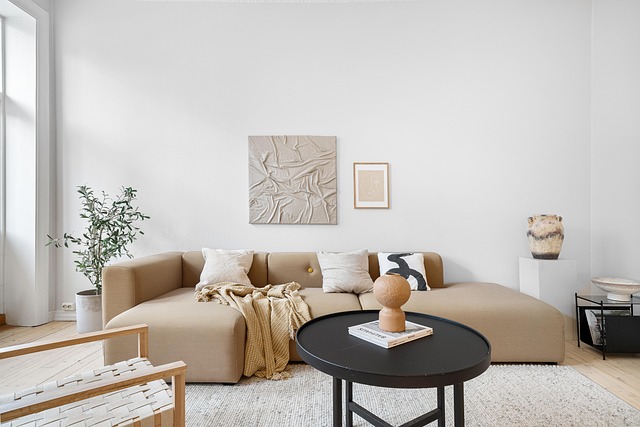Biophilic design utilizes natural elements like plants and water features to create calming spaces that connect humans with nature, especially in urban areas where outdoor access is limited. Strategic indoor plant arrangements enhance aesthetics, reduce stress, improve air quality, and boost cognitive performance. Plants serve as key aesthetic components, blending with various interior styles while acting as natural air purifiers and contributing to psychological well-being. Implementing indoor plant arrangement through vertical gardens or cascading plants can transform ordinary spaces into serene oases that foster calmness and a connection to nature.
“Discover the transformative power of biophilic design, a revolutionary approach that harmonizes human well-being with nature. This article explores how incorporating natural elements into indoor spaces can significantly enhance aesthetics and promote mental health. From understanding the core principles to practical solutions like strategic indoor plant arrangement—a key element proven to boost ambiance—we uncover ways to create vibrant, healthy environments. Learn about aesthetic considerations and effective implementation strategies for biophilic design, culminating in spaces that are both visually appealing and conducive to well-being.”
Understanding Biophilic Design and Its Impact on Well-being
Biophilic design is an approach that connects humans with nature, bringing natural elements into built environments. It leverages the power of indoor plant arrangement and other organic features to enhance well-being and aesthetics. This design philosophy is based on the idea that people have an innate connection to nature, and by incorporating natural elements like plants, water features, and organic materials, we can create spaces that foster a sense of calm and revitalization.
Research has shown that biophilic design solutions, including strategic indoor plant arrangements, can significantly reduce stress levels, improve air quality, and enhance cognitive performance. The presence of greenery and other natural motifs not only adds visual appeal but also creates a more harmonious and soothing atmosphere. This is particularly important in urban settings where access to outdoor spaces may be limited, making biophilic design an effective strategy for creating healthy and vibrant indoor environments.
Indoor Plant Arrangement: A Key Biophilic Element
Indoor plant arrangement is a pivotal biophilic element that significantly enhances well-being and aesthetics in spaces. Plants, as natural elements, introduce a sense of calm and connectivity to nature, fostering a positive environment for both mind and body. Strategic placement and thoughtful design of indoor plants can transform any interior space into a vibrant oasis.
Arranging indoor plants involves more than just aesthetic considerations. It includes understanding the specific needs of various plant species, such as light exposure, water requirements, and air purification capabilities. By integrating these biological necessities into the design plan, spaces become not only visually appealing but also healthier and more balanced. The interplay of foliage, textures, and colors in indoor plant arrangements adds depth and interest, creating a harmonious blend that elevates the overall ambiance of any environment.
Aesthetic Considerations in Biophilic Design
Biophilic design prioritises natural elements and patterns within interior spaces, not just for environmental sustainability but also to enhance human well-being and aesthetics. When considering the aesthetic side of biophilic design, one of the key components is incorporating indoor plant arrangement. Plants act as living, breathing additions that instantly connect occupants with nature, fostering a sense of calm and improving air quality. Strategic placement of plants, whether in the form of vertical gardens, hanging baskets, or scattered across desks, can create visually pleasing spaces while promoting psychological comfort and productivity.
The beauty of biophilic design lies in its ability to blend seamlessly with existing decor, from modern minimalist aesthetics to traditional rustic styles. Indoor plant arrangements can be tailored to complement existing color palettes, furniture choices, and architectural features. Well-designed plant selections not only add a touch of nature’s charm but also serve as focal points, enhancing the overall allure of any space.
Implementing Biophilic Solutions for Healthy Spaces
Implementing biophilic solutions is a powerful way to create healthy and aesthetically pleasing spaces. One of the simplest yet most effective methods is incorporating indoor plant arrangement. Plants act as natural air purifiers, removing toxins and improving indoor air quality. They also contribute to psychological well-being by reducing stress levels and enhancing mood. An array of greenery scattered across a space can transform an ordinary environment into a serene oasis, fostering a sense of calm and connection to nature.
Indoor plant arrangement can take various forms, from vertical gardens that maximize wall space to cascading plants that create focal points. Strategically placing these green additions near windows allows sunlight to enhance their growth while providing natural light and a view of the outdoors, further blurring the lines between interior and exterior environments. This integration of nature into our built spaces is at the core of biophilic design, promoting a healthier, happier, and more connected lifestyle.
Biophilic design, by integrating natural elements like indoor plant arrangement, offers a compelling solution to enhance both aesthetics and well-being. As discussed, strategically placing plants within spaces not only beautifies environments but also fosters a deeper connection with nature, leading to improved mental and physical health. Embracing these biophilic principles can transform interior spaces into thriving oases that promote balance and harmony, ultimately enriching our lives and communities.
